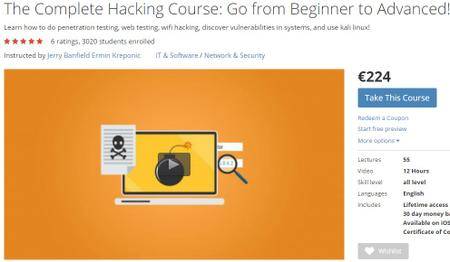Published 6/2024
Created by TI Digitals
MP4 | Video: h264, 1280×720 | Audio: AAC, 44.1 KHz, 2 Ch
Genre: eLearning | Language: English | Duration: 41 Lectures ( 2h 32m ) | Size: 1.06 GB
“Shielding Against Digital Threats: A Practical Approach to Cybersecurity”
What you’ll learn:
Learning about securing network infrastructure, including firewalls, intrusion detection/prevention systems (IDS/IPS), virtual private networks (VPNs).
Understanding security measures for various operating systems (Windows, Linux, etc.)
Studying encryption algorithms, cryptographic protocols, digital signatures, and cryptographic key management for securing data in transit and at rest.
how to respond to security incidents, including incident detection, containment, eradication, and recovery, as well as digital forensics techniques,
Exploring the unique security challenges posed by Internet of Things (IoT) devices, including device authentication, data encryption, and protecting against IoT
Requirements:
high school diploma or equivalent , A Computer system with internet access.
Description:
In today’s interconnected world, the importance of cybersecurity cannot be overstated. As our reliance on digital technology grows, so does the need to protect our digital assets and information from cyber threats. This course provides a comprehensive introduction to cybersecurity, covering fundamental concepts, techniques, and best practices for safeguarding against cyber attacks.Throughout the course, students will explore various aspects of cybersecurity, including threat landscapes, attack vectors, risk assessment, and mitigation strategies. They will gain a solid understanding of key cybersecurity principles and frameworks, such as confidentiality, integrity, availability (CIA), and the cybersecurity kill chain model.Topics covered include:Introduction to Cybersecurity: Understanding the importance of cybersecurity in today’s digital world and its impact on individuals, organizations, and society.Cyber Threats and Attack Vectors: Exploring common cyber threats, including malware, phishing, ransomware, and social engineering, and understanding how cyber attackers exploit vulnerabilities to infiltrate systems and networks.Risk Assessment and Management: Learning how to identify, assess, and prioritize cybersecurity risks, and developing risk management strategies to mitigate potential threats.Security Controls and Best Practices: Examining a range of cybersecurity controls and best practices, including access controls, encryption, authentication mechanisms, and security awareness training.Incident Response and Recovery: Understanding the importance of incident response planning and developing procedures to detect, contain, and recover from cybersecurity incidents effectively.Legal and Ethical Considerations: Exploring legal frameworks, regulations, and ethical considerations related to cybersecurity, including data protection laws, intellectual property rights, and privacy concerns.Through a combination of lectures, hands-on exercises, case studies, and real-world examples, students will develop the knowledge and skills necessary to assess cybersecurity risks, implement effective security measures, and protect digital assets and information against cyber threats.
Who this course is for:
individuals interested in pursuing careers or furthering their knowledge in the field of cybersecurity.
Homepage
https://anonymz.com/?https://www.udemy.com/course/cyber-security-mastering-for-2025/










